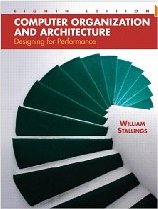Text: |

Computer Organization and Architecture
Designing for Performance
Eighth Edition (2009)
William Stallings
Pearson Prentice Hall
ISBN-13: 978-0-13-608860-8
|
|
This book is about the structure and function of computers. Its purpose is to present, as clearly and completely as possible, the nature and characteristics of modern-day computer systems.
A computer system, like any system, consists of an interrelated set of components. The system is best characterized in terms of structure - the operation of the individual components. Futhermore, a computer's organization is hierarchical. Each major component can be further described by decomposing it into its major subcomponents and describing their structure and function. For clarity and ease of understanding, this hierarchical organization is described in this book from the top down:
- Computer System: Major components are processor, memory, and I/O,
- Processor: Major components are control unit, registers, ALU, and instruction,
- Control Unit: Provides control signals for the operation and coordination of all processor components. Traditionally, microprogramming implementation has been used. More recently, microprogramming has been less prominent but remains an implementation technique.
Website: http://www.williamstallings.com/COA/COA8e.html | |
References: |
Introduction to Computing Systems, From Bits & Gates to C & Beyond, Yale N. Patt & Sanjay J. Patel, McGraw Hill, 2004
Computer Organization and Design: The Hardware/Software Interface, (Fourth Edition),
David A. Patterson & John L. Hennessy, Morgan Kaufmann Publishers (Elsevier Inc.), 2009
Structured Computer Organization (5th Edition), Andrew S. Tannenbaum, Pearson Prentice Hall, 2006
Computer Systems (Third Edition), J. Stanly Warford, Jones & Bartlett Publishers, 2005
LogicWorksTM 5 Interactive Circuit Design Software, Capilano Computing, Pearson Prentice Hall, 2004
Digital Design: Principles and Practices Package (4th Edition), John F. Wakerly, Prentice Hall, 2005
The Art of Electronics (2nd Edition), Paul Horowitz and Winfield Hill, Cambridge press, 1989
|
|
Week: |
Date |
Topic |
Reading |
Lecture Slides/References |
Assignment (Due 2nd period after assigned
30% deduction after due class
50% deduction next class) |
|
1: |
Thur - Oct 1 |
Organization, Registers, Data Paths, Timing, Buses, Stacks, Memory Maps |
Chap 0, 2.1, 2.4-2.5, 3.1-3.4, 3.A |
Introduction/Review Slides
Homework Format
|
|
|
2: |
Tue - Oct 6 |
ISA Comparisons, Addressing, RISC & CISC |
Chap 13.1,13.4 |
ISA, RISC/CISC Slides |
HW1: Context Switching |
|
|
Thur - Oct 8 |
Arithmetic, Floating Point |
Chap 9.3-9.5 |
Arith, FP Slides |
HW2: 9-15,18,20,24,31,38,39,40
|
|
3 : |
Tue - Oct 13 |
Memory Hierarchy: Internal Memory & Issues, Cache Memory Systems |
Chap 5.1, 5.3, 4.1-4.2 |
Memory & Direct Cache |
|
|
|
Thur - Oct 15 |
Cache Memory Systems |
Chap 4.3 |
Cache Memory |
HW3: 5-2,8 4-1,5,11,23
|
|
4 : |
Tue - Oct 20 |
Error Detection/Correction |
Chap 5.2 |
Hamming Code |
HW4: 5-11,12
|
|
|
Thur - Oct 22 |
Midterm (Thru Cache Memory Systems) |
|
Midterm 1 Solution |
|
|
5 : |
Tue - Oct 27 |
External Memory, Memory Sharing, Interrupts |
Chap 6, 7.1-7.4 |
External Memory |
Midterm - Problem 6 (Due 10/29)
|
|
|
Thur - Oct 29 |
Interrupts, DMA, Channels, Contexts, Context Switching |
Chap 7.5-7.6 |
DMA & Channels |
HW5: 6-3,4 7-9,10,11,12(use Crum's definition of cycle stealing)
|
|
6 : |
Tue - Nov 3 |
Operating System Support: Scheduling, Multi-Tasking/Threading, Memory Management |
Chap 8.1- 8.3 |
OS support |
HW6a: 8-8,15,17
|
|
|
Thur - Nov 5 |
Mem Man:Paging, Virtual Memory; Pipelining |
Chap 12.4 |
Pipelining |
HW6b: 12-7,10
|
|
7 : |
Tue - Nov 10 |
RISC specific: Register Files, Register Optimization |
Chap 13.2-13.3, 13.5 |
RISC Pipelining |
|
|
|
Thur - Nov 12 |
No Class |
|
|
|
|
8 : |
Tue - Nov 17 |
RISC Specific: Pipelining; Review |
|
MIPS Pipelining |
|
|
|
Thur - Nov 19 |
Midterm (Thru Nov 5th Material) |
|
Midterm 2 Solution |
|
|
9 : |
Tue - Nov 24 |
Superscalar Machines (class cancelled) |
Chap 14.1-14.2 |
Superscalar Machines |
|
|
|
Thur - Nov 26 |
Thanksgiving |
|
|
|
|
10 : |
Tue - Dec 1 |
Superscalar Machines |
Chap 14.1-14.2 |
Superscalar Machines |
HW7: 12- 7,8 13-6,7 MIPS 14-5,6
|
|
|
Thur - Dec 3 |
Predication, Speculation, & Software Pipelining (IA-64 or EPIC) |
Chap 21.1-21.5 |
IA-64 EPIC Architecture |
|
|
11 : |
Tue - Dec 8 |
Control Units: Hardwired State Machines vs Microprogrammed,
Multithreading, Clusters |
Chap 15.1-15.4, 16.1-16.3, 17.4-17.5 |
Control Units
Parallel Processing |
|
|
|
Thur - Dec 10 |
Multicore Machines, Recap |
Chap 18.1-18.4 |
Multicore Machines
Final Prep |
|
|
12 : |
Thur - Dec 17 |
Final Exam |
|
Final Exam Solution
|
